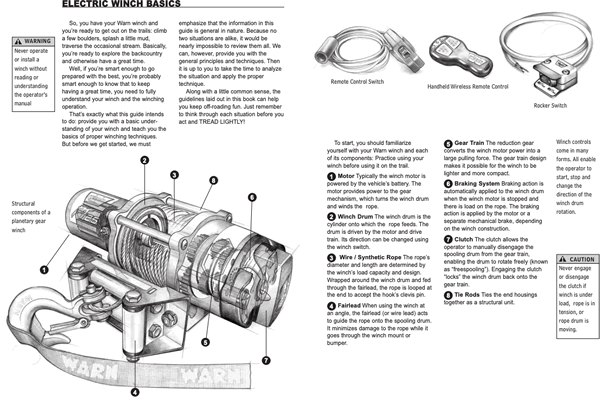It’s the time of year when the weather can’t decide if it’s going to melt or snow from day to day. The trend is warming from here out though so the snow will vary from frozen/icy conditions in the morning and shaded sites and progressing to sloppy wet snow in the afternoons which means you’re gonna get stuck and need your winch!
How well do you know your winch?
Good question right, the manual that came with your winch was one of the first casualties when you tore into the packaging to see your fancy new winch. You’re in luck though because most manufacturers make their manuals available for download via their website. Grab your manual or hop over to the manufacturer’s website and download it then give it a good read, there’s a surprising amount you’ll learn about your winch.

Download Warn’s Basic Guide to Winching Techniques – PDF
Winch Safety
Life saver or life taker, it’s all in how you use any tool. We seldom use our winch unless someone is stuck or in a precarious position so there’s always a heightened amount of risk when using a winch.
- Understanding how our winch works – we found the manual and read up on our winch so we know how the switch works, how to engage/disengage the clutch, and how long we can run the winch before we need to give it a break to cool before further use.
- Brought our bag of winch accessories – so we can connect to trees or other machines without damaging, gloves to protect our hands and extra rope/cable/strap because you’ll always be stuck exactly 6″ further than the nearest solid object your winch line can reach.
- Assess the situation – to determine if we need to act quickly to prevent a machine from rolling or if we have time to plan how to extract the machine from the prickly predicament you’ve positioned yourself in.
- Communicate the plan – if you’re riding alone or with others you want to think and talk through your plan to ensure it’s a good plan and that everyone understands how to proceed.
- Time to rig up for the pull – employing all the gear you’ve brought get everything hooked up for the big moment. Remember to place a jacket, bag, tree branch over the cable to suppress the energy of the cable recoiling back at you should the cable break.
- Final checks – everyone reviews the plan and makes sure we’ve covered all the possible things that could go wrong. Now it’s time to get your wheeler back on the trail.
- Success!
Winch Horror Stories
Unfortunately we’ve all probably heard or seen our share of winching horror stories, here are a few so you can avoid them yourself:

- Pinch Zone Danger! – winches exert amazing force and they love the taste of fingers. ALWAYS, ALWAYS, ALWAYS hold the strap, not the hook when reeling in your winch. Take it slow when you get near the fairlead and even just let it go, it’s not worth getting your finger or hand crushed.
- People Pulling Midspan – we’ve seen people grab the cable just as tension is coming up resulting in the cable pulling the person to the ground or pinning them against an object. Just stay the heck out of the way when winching is underway.
- Pulling the Wrong Direction – be aware of where your machine is going to go as it’s pulled out and avoid pulling on an angle because it can pull your machine on its side or roll it.
- When the Cable Snaps – you’ve gone through all the work of getting your machine almost all the way back to the top then snap, it’s off on another adventure back down the hillside. Check your cables, look for obstacles that are going to create resistance in your pull and consider having a second strap securing your machine should the main pull cable break.